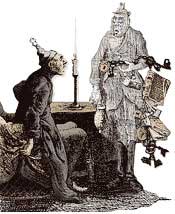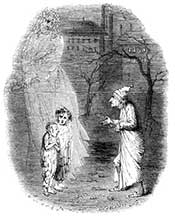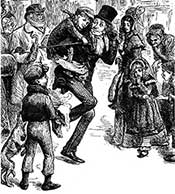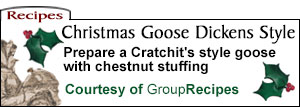The Charles Dickens Page
Charles Dickens'
A Christmas Carol
A Christmas Carol in Prose - Being a Ghost Story of Christmas
A Christmas Carol - Published in one volume - Dec 1843
Characters
Illustrations
Fifteen Bob a Week
Ignorance and Want
The Death of Tiny Tim
Dead as a Doornail
Sabbatarianism
Cooking the Cratchit's Christmas Goose
Liz Smith
Preface to the Original Edition
Bob Cratchit and Tiny Tim
The Fezziwig Ball
Sir Roger de Coverley
Camden Town
Piracy
Staves
Christmas Goose Recipe
Vote for your favorite film version
Blind Man's Buff
Lionel Barrymore as Scrooge
My favorite film version
Thackeray on the Carol
Read a condensed version
Praise for the Carol
Charles Dickens and the Ghost Club
Books and Videos
Charles Dickens began writing A Christmas Carol in October, 1843 finishing it by the end of November in time to be published for Christmas with illustrations by John Leech. Feuding with his publishers, Dickens financed the publishing of the book himself, ordering lavish binding, gilt edging, and hand-colored illustrations and then setting the price at no more than five shillings (Slater, 2009, p. 220).
This combination resulted in disappointingly low profits despite high sales. In the first few days of its release the book sold six thousand copies and its popularity continued to grow (Patten, 1978, p. 146). The first and best of his Christmas Books, A Christmas Carol has become a Christmas tradition and easily Dickens' best-known book.
Plot
(contains spoilers)
Ebenezer Scrooge is a penny-pinching miser in the first degree. He cares nothing for the people around him and mankind exists only for the money that can be made through exploitation and intimidation. He particularly detests Christmas which he views as 'a time for finding yourself a year older, and not an hour richer'. Scrooge is visited, on Christmas Eve, by the ghost of his former partner Jacob Marley who died seven Christmas Eves ago.
Marley, a miser from the same mold as Scrooge, is suffering the consequences in the afterlife and hopes to help Scrooge avoid his fate. He tells Scrooge that he will be haunted by three spirits. These three spirits, the ghosts of Christmas past, present, and future, succeed in showing Scrooge the error of his ways. His glorious reformation complete, Christmas morning finds Scrooge sending a Christmas turkey to his long-suffering clerk, Bob Cratchit, and spending Christmas day in the company of his nephew, Fred, whom he had earlier spurned.
Scrooge's new-found benevolence continues as he raises Cratchit's salary and vows to assist his family, which includes Bob's crippled son, Tiny Tim. In the end Dickens reports that Scrooge became "as good a friend, as good a master, and as good a man, as the good old city knew" (Christmas Books-A Christmas Carol, p. 76).
Complete List of Characters:
Character descriptions contain spoilers
Belle
Caroline
Cratchit, Bob
Cratchit, Mrs
Cratchit, Belinda
Cratchit, Martha
Cratchit, Peter
Cratchit, Tiny Tim
Dilber, Mrs
Fan
Fezziwig
Fezziwig, Mrs
Fred
Ghost of Christmas Past
Ghost of Christmas Present
Ghost of Christmas Yet to Come
Marley, Jacob
Joe, Old
Scrooge, Ebenezer
Topper
Wilkins, Dick
A Christmas Carol Links:
Dickens and Christmas
Dickens' Christmas Books
Dickens A Christmas Carol reading text
Thackeray on A Christmas Carol
Download A Christmas Carol in a text file
The Second Greatest Christmas Story Ever Told - By Thomas J. Burns (Originally published in Reader's Digest, December 1989)
SparkNotes - A Christmas Carol
Original Illustrations
John Leech provided eight illustrations for A Christmas Carol. Four woodcuts and four hand colored etchings:
 |
 |
 |
 |
 |
 |
 |
 |
Select an image to see a larger version
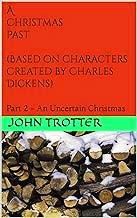 A Christmas Past-Part 2
by John Trotter
A Christmas Past-Part 2
by John Trotter
Sequel to A Christmas Past, set 7 years later. All proceeds go to charity.
A Christmas Carol
Further Information
My Favorite Fred
Barry Mackay, from the 1938 verion of A Christmas Carol, played a delightful Fred, Scrooge's jolly nephew.
Fifteen Bob a Week
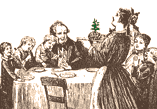 The miserly Scrooge paid his clerk, Bob Cratchit, a weekly salary of fifteen shillings (cockney slang for shilling was "bob"). Bob "pocketed on Saturdays but fifteen copies of his Christian name" (Christmas Books-A Christmas Carol, p. 43).
The miserly Scrooge paid his clerk, Bob Cratchit, a weekly salary of fifteen shillings (cockney slang for shilling was "bob"). Bob "pocketed on Saturdays but fifteen copies of his Christian name" (Christmas Books-A Christmas Carol, p. 43).
According to C. Z. Barnett in his play A Christmas Carol or The Miser's Warning (1844) Cratchit would have spent a week's wages to buy the ingredients for the Christmas feast: seven shillings for the goose, five for the pudding, and three for the onions, sage and oranges.
Ignorance and Want
One major theme in A Christmas Carol was rooted in Dickens' observations of the plight of the children of London's poor. It has been said of the times that sex was the only affordable pleasure for the poor; the result was thousands of children living in unimaginable poverty, filth, and disease. In 1839 nearly half of all funerals in London were for children under the age of ten (Ackroyd, 1990, p. 384). Those who survived grew up without education or resource and virtually no chance to escape the cycle of poverty. Dickens felt that this vicious circle could only be broken through education and became interested in the Ragged Schools in London.
Ragged Schools were free schools, run through charity, in which the poorest children received religious instruction and a rudimentary education. Dickens generally applauded the work of these schools although he disapproved of introducing religious doctrine at the expense of a practical education which would help the pupil become a self-sufficient member of society (Ackroyd, 1990, p. 406-407). Despite the availability of these schools, most poor children remained uneducated due to the demand for child labor and the apathy of parents, wretchedly poor and uneducated themselves.
Dickens introduces these children in A Christmas Carol through the allegorical twins, Ignorance and Want. The Ghost of Christmas Present shows them, wretched and almost animal in appearance, to Scrooge with the warning: "This boy is Ignorance. This girl is Want. Beware them both, and all of their degree, but most of all beware this boy, for on his brow I see that written which is Doom, unless the writing be erased" (Christmas Books-A Christmas Carol, p. 57).
Charles Dickens continued to support education for the poor through his works but compulsory education for all did not come about until 1870, the year of Dickens' death.
The Death of Tiny Tim
Of all the affecting scenes from A Christmas Carol none touches the heart more than the death of the crippled Tiny Tim, 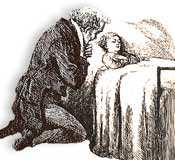 foreshadowed to Scrooge by the Ghost of Christmas Yet to Come, especially to Victorian readers. Large families and child mortality were common in the 19th century and many readers may have suffered firsthand the loss of a child.
foreshadowed to Scrooge by the Ghost of Christmas Yet to Come, especially to Victorian readers. Large families and child mortality were common in the 19th century and many readers may have suffered firsthand the loss of a child.
Michael Patrick Hearn, in his book The Annotated Christmas Carol, notes that Clarence Cook, reporting for the New York Tribune after attending a public reading by Dickens of A Christmas Carol in Boston in 1867, noted that the passage of Tiny Tim's death "brought out so many pocket handkerchiefs that it looked as if a snow-storm had somehow gotten into the hall without tickets" (Hearn, 2004, p. 249, n. 2).
Dead as a Doornail
Dickens begins A Christmas Carol by impressing upon the reader that Jacob Marley was dead. In fact, he was "dead as a doornail." He goes on to question this well-known simile:
"Mind! I don't mean to say that I know, of my own knowledge, what there is particularly dead about a door-nail. I might have been inclined, myself, to regard a coffin-nail as the deadest piece of ironmongery in the trade. But the wisdom of our ancestors is in the simile; and my unhallowed hands shall not disturb it, or the Country's done for. You will therefore permit me to repeat, emphatically, that Marley was as dead as a door-nail" (Christmas Books-A Christmas Carol, p. 7).
The phrase "dead as a doornail" appears as early as the fourteenth-century in The Vision of Piers Plowman and later in Shakespeare's Henry IV. However, the origin of the phrase is unknown. One possible explanation is that doors were built using only wood boards and hand forged nails, the nails were long enough to dead nail the (vertical)  wooden panels and (horizontal) stretcher boards securely together, so they would not easily pull apart. This was done by pounding the protruding point of the nail over and down into the wood. A nail that was bent in this fashion (and thus not easily pulled out) was said to be "dead", thus "dead as a doornail." (Wiktionary)
wooden panels and (horizontal) stretcher boards securely together, so they would not easily pull apart. This was done by pounding the protruding point of the nail over and down into the wood. A nail that was bent in this fashion (and thus not easily pulled out) was said to be "dead", thus "dead as a doornail." (Wiktionary)
Sabbatarianism
Sabbatarianism, the Christian doctrine of strict observance of Sunday as a holy day reserved for worship, was attacked by Dickens throughout his life.  In 1836 he published the pamphlet Sunday Under Three Heads in opposition to a Bill that would have extended already strict limitations to Sunday recreation. Dickens felt that these Bills were an attempt by the upper classes to control the lives of the lower classes disguised as religious piety (Slater, 2009, p. 70-71). He argued that Sunday was the only day that the poor and working classes could enjoy simple pleasures that the upper and middle classes enjoyed all week. In A Christmas CarolDickens again voices these concerns through this exchange between Scrooge and the Ghost of Christmas Present:
In 1836 he published the pamphlet Sunday Under Three Heads in opposition to a Bill that would have extended already strict limitations to Sunday recreation. Dickens felt that these Bills were an attempt by the upper classes to control the lives of the lower classes disguised as religious piety (Slater, 2009, p. 70-71). He argued that Sunday was the only day that the poor and working classes could enjoy simple pleasures that the upper and middle classes enjoyed all week. In A Christmas CarolDickens again voices these concerns through this exchange between Scrooge and the Ghost of Christmas Present:
"Spirit," said Scrooge, after a moment's thought, "I wonder you, of all the beings in the many worlds about us, should desire to cramp these people's opportunities of innocent enjoyment."
"I!" cried the Spirit.
"You would deprive them of their means of dining every seventh day, often the only day on which they can be said to dine at all," said Scrooge. "Wouldn't you?"
"I!" cried the Spirit.
"You seek to close these places on the Seventh Day," said Scrooge. "And it comes to the same thing."
"I seek!" exclaimed the Spirit.
"Forgive me if I am wrong. It has been done in your name, or at least in that of your family," said Scrooge.
"There are some upon this earth of yours," returned the Spirit, "who lay claim to know us, and who do their deeds of passion, pride, ill-will, hatred, envy, bigotry, and selfishness in our name, who are as strange to us and all our kith and kin, as if they had never lived. Remember that, and charge their doings on themselves, not us" (Christmas Books-A Christmas Carol, p. 43.)
Cooking the Cratchit's
Christmas Goose

The homes of the poor were equipped with open fireplaces for heat and cooking but not with ovens. Thus many, like the Cratchits, took their Christmas goose or turkey to the baker's shop. Bakers were forbidden to sell on Sundays and holidays but would open their shops on these days to the poor and bake their dinners for a small fee. Dickens tells of Master Peter Cratchit and the two younger Cratchits going to fetch their Christmas goose from the bakers (Hearn, 2004, p. 91-92, n. 28).
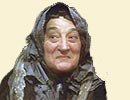
Liz Smith
(Born: Betty Gleadle December 11, 1921 in Scunthorpe, Lincolnshire, England) has the distinction of playing Mrs Dilber in two versions of A Christmas Carol: the 1984 version starring George C. Scott, and the 1999 version starring Patrick Stewart.Preface to the Original Edition
A Christmas Carol
I have endeavoured in this Ghostly little book, to raise the Ghost of an Idea, which shall not put my readers out of humour with themselves, with each other, with the season, or with me. May it haunt their houses pleasantly, and no one wish to lay it.
Their faithful Friend and Servant,
C. D.
December, 1843.
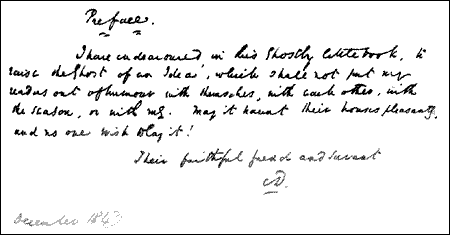
The Pierpont Morgan Library, New York. MA 97.
Bob Cratchit and Tiny Tim
It is interesting to note that the now famous scene, Bob Cratchit with Tiny Tim on his shoulder, was not illustrated in the original version.
The Fezziwig Ball
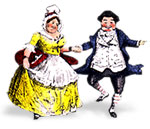 "Clear away! There was nothing they wouldn't have cleared away, or couldn't have cleared away, with old Fezziwig looking on. It was done in a minute. Every movable was packed off, as if it were dismissed from public life for evermore; the floor was swept and watered, the lamps were trimmed, fuel was heaped upon the fire; and the warehouse was as snug, and warm, and dry, and bright a ball-room, as you would desire to see upon a winter's night.
"Clear away! There was nothing they wouldn't have cleared away, or couldn't have cleared away, with old Fezziwig looking on. It was done in a minute. Every movable was packed off, as if it were dismissed from public life for evermore; the floor was swept and watered, the lamps were trimmed, fuel was heaped upon the fire; and the warehouse was as snug, and warm, and dry, and bright a ball-room, as you would desire to see upon a winter's night.
 In came a fiddler with a music book, and went up to the lofty desk, and made an orchestra of it, and tuned like fifty stomach-aches. In came Mrs Fezziwig, one vast substantial smile. In came the three Miss Fezziwigs, beaming and lovable. In came the six young followers whose hearts they broke" (Christmas Books-A Christmas Carol, p. 31).
In came a fiddler with a music book, and went up to the lofty desk, and made an orchestra of it, and tuned like fifty stomach-aches. In came Mrs Fezziwig, one vast substantial smile. In came the three Miss Fezziwigs, beaming and lovable. In came the six young followers whose hearts they broke" (Christmas Books-A Christmas Carol, p. 31).
Sir Roger de Coverley
Learn more about the dance performed at Fezziwig's Christmas Ball:
Learn the dance
Hear the music
Camden Town
 In 1822 ten year old Dickens moved with his family to 16 Bayham Street, Camden Town, in London. Dickens would later describe the area "as shabby, dingy, damp and mean a neighborhood as one would desire to see" (Ackroyd, 1990, p. 57-58). He used the house as a model for the home of the Cratchits in A Christmas Carol. Dickens would later use the house again as the home of the Micawbers in David Copperfield.
In 1822 ten year old Dickens moved with his family to 16 Bayham Street, Camden Town, in London. Dickens would later describe the area "as shabby, dingy, damp and mean a neighborhood as one would desire to see" (Ackroyd, 1990, p. 57-58). He used the house as a model for the home of the Cratchits in A Christmas Carol. Dickens would later use the house again as the home of the Micawbers in David Copperfield.
Piracy
 A Christmas Carol was published during the week before Christmas 1843 and was an instant sensation but, due to the high production costs, Dickens' earning from the sales were lower than expected. In addition to the disappointing profit from the book Dickens was enraged that the work was instantly the victim of pirated editions. Copyright laws in England were often loosely enforced and a complete lack of international copyright law had been Dickens' theme during his trip to America the year before. He ended up spending more money fighting pirated editions of the book than he was making from the book itself (Patten, 1978, p. 148-151).
A Christmas Carol was published during the week before Christmas 1843 and was an instant sensation but, due to the high production costs, Dickens' earning from the sales were lower than expected. In addition to the disappointing profit from the book Dickens was enraged that the work was instantly the victim of pirated editions. Copyright laws in England were often loosely enforced and a complete lack of international copyright law had been Dickens' theme during his trip to America the year before. He ended up spending more money fighting pirated editions of the book than he was making from the book itself (Patten, 1978, p. 148-151).
A Christmas Carol
 Dickens called his little Christmas book a carol; carol being a song or ballad of joy celebrating the birth of Christ. He carries the pretense further by calling the chapters staves; a stave being an archaic form of stanza or verse of a song. He used similar schemes in two subsequent Christmas books: The Chimes, in which he called the chapters "quarters" as in the tolling of the clock, and The Cricket on the Hearth, where the book is divided into "chirps".
Dickens called his little Christmas book a carol; carol being a song or ballad of joy celebrating the birth of Christ. He carries the pretense further by calling the chapters staves; a stave being an archaic form of stanza or verse of a song. He used similar schemes in two subsequent Christmas books: The Chimes, in which he called the chapters "quarters" as in the tolling of the clock, and The Cricket on the Hearth, where the book is divided into "chirps".
Blind Man's Buff
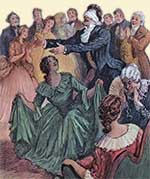 At Scrooge's nephew Fred's Christmas party they play blind man's buff, a popular Victorian parlor game. In this particular game the blind man, Topper, and Fred team up to allow Topper to be able to see through the blindfold so that he can catch a lady whom he has his eye on:
At Scrooge's nephew Fred's Christmas party they play blind man's buff, a popular Victorian parlor game. In this particular game the blind man, Topper, and Fred team up to allow Topper to be able to see through the blindfold so that he can catch a lady whom he has his eye on:
"There was first a game at blind-man's buff. Of course there was. And I no more believe Topper was really blind than I believe he had eyes in his boots. My opinion is, that it was a done thing between him and Scrooge's nephew; and that the Ghost of Christmas Present knew it. The way he went after that plump sister in the lace tucker, was an outrage on the credulity of human nature. Knocking down the fire-irons, tumbling over the chairs, bumping against the piano, smothering himself among the curtains, wherever she went, there went he. He always knew where the plump sister was. He wouldn't catch anybody else" (Christmas Books-A Christmas Carol, p. 53-54).
Lionel Barrymore
 A Christmas Carol became part of the celebration of Christmas in America due in part to Lionel Barrymore's annual (1931-1954) radio show where he played the Dickensian miser. That role was instrumental in his being cast as Henry F. Potter in It's a Wonderful Life (Davis, 1999, p. 21).
A Christmas Carol became part of the celebration of Christmas in America due in part to Lionel Barrymore's annual (1931-1954) radio show where he played the Dickensian miser. That role was instrumental in his being cast as Henry F. Potter in It's a Wonderful Life (Davis, 1999, p. 21).
My Favorite Film Version
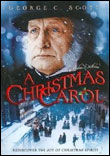 My favorite film version of A Christmas Carol is the 1984 made-for-TV version starring George C. Scott as Ebenezer Scrooge. Faithful to Dickens' original with much of the dialogue lifted right out of the book, this version includes an excellent cast: Susannah York, Roger Rees, David Warner, and Edward Woodward, supporting the cranky Scott who is perfect as Scrooge.
My favorite film version of A Christmas Carol is the 1984 made-for-TV version starring George C. Scott as Ebenezer Scrooge. Faithful to Dickens' original with much of the dialogue lifted right out of the book, this version includes an excellent cast: Susannah York, Roger Rees, David Warner, and Edward Woodward, supporting the cranky Scott who is perfect as Scrooge.
The film was shot in locations in and around the town of Shrewsbury, England and has the gritty look and feel of early nineteenth-century London. Scrooge's grave from the film can still be seen in the graveyard of St Chad's church.
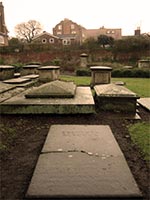
Scrooge's grave at St. Chad's churchyard
Thackeray on the Carol
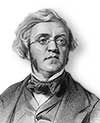 William Makepeace Thackeray in Fraser's Magazine (February 1844) pronounced the book, "a national benefit and to every man or woman who reads it, a personal kindness. The last two people I heard speak of it were women; neither knew the other, or the author, and both said, by way of criticism, 'God bless him!'"
William Makepeace Thackeray in Fraser's Magazine (February 1844) pronounced the book, "a national benefit and to every man or woman who reads it, a personal kindness. The last two people I heard speak of it were women; neither knew the other, or the author, and both said, by way of criticism, 'God bless him!'"
Thackeray wrote about Tiny Tim, "There is not a reader in England but that little creature will be a bond of union between the author and him; and he will say of Charles Dickens, as the woman just now, 'GOD BLESS HIM!' What a feeling this is for a writer to inspire, and what a reward to reap!" (Frasers, 1844, p. 167-169 signed with the initials M.A.T. for Thackeray's pen name Michael Angelo Titmarsh).

Charles Dickens pared down A Christmas Carol for his public readings. Read an annotated version of Dickens' own reading text that can be read in a single sitting!
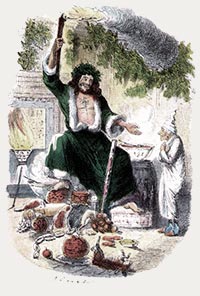
Praise for the Carol
Charles Dickens' friend and biographer, John Forster, relayed the outpouring of praise from readers Dickens received:
"There poured upon its author daily, all through that Christmas time, letters from complete strangers to him which I remember reading with a wonder of pleasure; not literary at all, but of the simplest domestic kind; of which the general burden was to tell him, amid many confidences, about their homes, how the Carol had come to he read aloud there, and was to be kept upon a little shelf by itself, and was to do them no end of good. Anything more to be said of it will not add much to this" (Forster, 1899, v. 1, p. 346).
Charles Dickens and
The Ghost Club
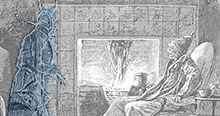
The Ghost Club was founded in London in 1862 and, after initially receiving some light-hearted ridicule in the press, Charles Dickens joined the club, lending it a degree of respectability. The club discussed and investigated ghosts and paranormal activities. After Dickens' death in 1870 the club seems to have dissolved. It enjoyed a resurgence in the early 1880s and is still in existence today.
Books
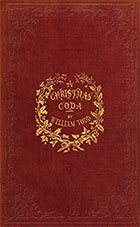 A Christmas Coda
A Christmas Coda
by Will Todd (2016)
Easily the best Carol sequel I have read. Superbly written with a distinct Dickensian flavor. You won't be disappointed!
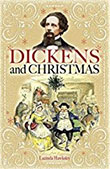 Dickens and Christmas
Dickens and Christmas
by Lucinda Hawksley (2017)
Explore the celebration of Christmas that Dickens helped to create written by a direct descendant of the great author himself!
 The Man Who Invented Christmas
The Man Who Invented Christmas
by Les Standiford (2008)
The story of how Charles Dickens's A Christmas Carol rescued his career and revived our holiday spirits. Movie version starring Dan Stevens, Christopher Plummer, and Jonathan Pryce was released in 2017.
 The Annotated Christmas Carol
The Annotated Christmas Carol
by Michael Patrick Hearn
Anything and everything about Dickens' timeless Christmas story (2003)
Read an interview with the author
Video
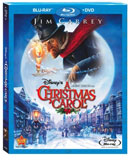 Disney's A Christmas Carol (2009)
Disney's A Christmas Carol (2009)
Fact Sheet
 A Christmas Carol (1984)
A Christmas Carol (1984)
George C. Scott
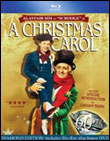 A Christmas Carol (1951)
A Christmas Carol (1951)
Alastair Sim
 Scrooge (1970)
Scrooge (1970)
Musical, Albert Finney
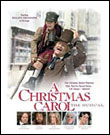 A Christmas Carol (2004)
A Christmas Carol (2004)
Kelsey Grammer, Jason Alexander, Jennifer Love Hewitt
 Muppet Christmas Carol (1992)
Muppet Christmas Carol (1992)
Michael Caine
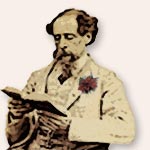
The Spirit at your Elbow
Part of the charm of A Christmas Carol is in the way Dickens addresses the reader, as if he is sitting beside you telling the story:
"The curtains of his bed were drawn aside; and Scrooge, starting up into a half-recumbent attitude, found himself face to face with the unearthly visitor who drew them: as close to it as I am now to you, and I am standing in the spirit at your elbow" (Christmas Books-A Christmas Carol, p. 24).

